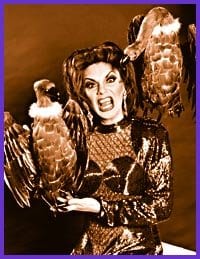When Michael Rowe was editing the horror anthology Queer Fear, to be released by Arsenal Pulp Press this month, he had difficulty explaining to people that the stories were not pornographic.
“If anyone was looking to flog the bishop over them, they were in for disappointment,” says Rowe.
Traditionally, much of gay and lesbian literature has been erotica. By contrast, the horror genre has been built on heterosexual content, with a male antagonist and his female victim.
If you look very closely, you’ll find a gay minor character but they usually die. Stephen King has written many gay minor characters, almost all of them negatively portrayed and almost all of them dying a gruesome death. Even openly gay horror film writer and director Kevin Williamson (Scream and Scream 2), kills off the gay bodyguard hired to protect Sidney.
There are some noteworthy shining lights in the genre. Poppy Z Brite writes amazing gay characters. Her novels Lost Souls, Drawing Blood, Wormwood and Exquisite Corpse all have gay male vampires. Rick R Reed wrote A Face Without A Heart, a modern-day version of Oscar Wilde’s The Picture Of Dorian Gray. Anne Rice is also well known for her portrayal of gay vampires in The Vampire Chronicles series. Whitley Strieber wrote The Hunger, upon which the popular lesbian vampire film was based. Beyond vampires, though, there’s not much queer and scary this side of Clive Barker (though some might consider horror film director James Whale, who directed Bride Of Frankenstein in 1935, a pioneer).
“Even vampire fiction has gotten awfully drippy and romance-driven,” Rowe says. “There’s way too much overblown purple prose about unhappy women waiting for their leather-clad dark lover in smoky goth nightclubs. A lot of it reads like warmed-over Harlequin romances, and has nothing to do with horror fiction.”
But Rowe contents that the readers “for powerful, scary, gay-themed horror fiction are there.”
Why? Horror encompasses and reflects common fears of the gay and lesbian community, yet also reflects our different personal experiences. We are surrounded by real-life horrors: AIDS, hate crimes, discrimination and prejudice. This may not make horror seem very entertaining. But think of closeted life, the fear, the loathing, and the sinister realities of the hetero world. For the majority of us, coming out was not as difficult as we feared.
Rowe is well-positioned to put out an anthology where all the protagonists are homo. In 1997, Rowe joined forces with Thomas S Roche and edited an anthology of gay vampire stories, Sons Of Darkness, for San Francisco’s Cleis Press. It was followed by the sequel, Brothers Of The Night, and Cleis Press also published a collection of lesbian vampire stories, Daughters Of Darkness, edited by Pam Keesey.
Rowe had wanted to publish a general gay horror anthology for years. When Sons Of Darkness was nominated for a Lambda Literary Award, he realised it was possible. Vancouver’s Arsenal Pulp Press was enthusiastic and Rowe embraced them: “Everyone there is very hip, so this was the perfect forum for my book.”
Gay characterisation, not necessarily gay writers, drive the anthology. The contributors include noteworthies such as Douglas Clegg, Gemma Files (of Eye magazine fame), Brian Hodge and Nancy Kilpatrick.
“It’s also interesting to me that I’ve worked with a number of brilliant horror writers who are straight, and who have written wonderful stories to me,” says Rowe. “I’m only half-kidding when I say that a significant number of straight men will do anything to avoid writing about ‘the act,’ so we get these lush, rich, layered stories from them. I love those guys.”
All this doesn’t mean that sex is absent in the queer horror genre. Rowe himself happens to be a fan of well-written porn. His first book, the non-horror title Writing Below The Belt, is a defence for pornography as a valid genre. He says that assuming gay-inflected writing in any genre is pornography because of the acts it describes, demeans gay writing in general. And it invalidates some of the truly wonderful porn out there.
“Which is not to say that some of [the stories in Queer Fear] aren’t very sexy, which is fabulous,” he says.
The definitive reference for queers in science fiction, fantasy and horror is Uranian Worlds by Eric Garber and Lyn Paleo, published by GK Hall & Company. Monsters In The Closet: Homosexuality And The Horror Film by Harry M Benshoff, published by Manchester University Press, is a good reference for queers in horror films.
On-line, www.queerhorror.com is a site devoted to the horror genre, and how it affects gays, lesbians, bisexuals and the transgendered.

 Why you can trust Xtra
Why you can trust Xtra


